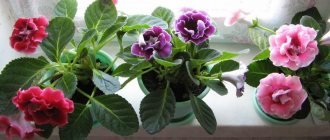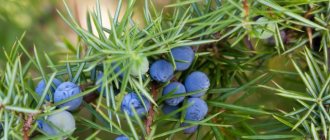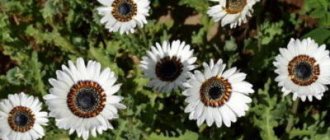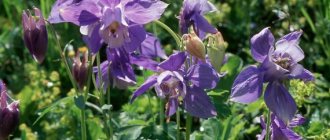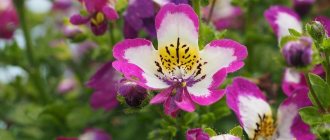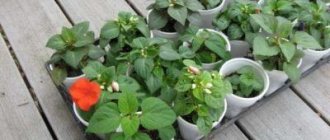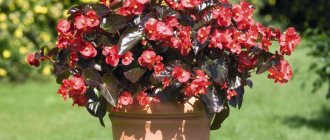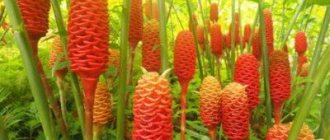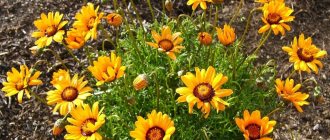- General description of the balsam plant
- Popular varieties and types of balsam
- Caring for indoor balsam
- Lighting and temperature conditions
- Watering and humidity
- Soil and fertilizers
- Pruning indoor balsam
- Choosing a pot for indoor balsam
- Dormant period: caring for balsam in winter
- Impatiens transplant
- Methods for propagating indoor balsam
- Propagation of balsam by cuttings
- Propagation of balsam by seeds
- How to collect balsam seeds yourself
- Pests and diseases of balsam
- Problems when growing balsam
- Video: how to propagate balsam
Indoor balsam is a perennial plant that is unpretentious. People called him Vanka the Wet and the Light. There are many varieties of balsam that even amateur gardeners can grow on the windowsill.
The Balsam flower, due to its special properties, is popularly known by many other names.
A beautiful and profusely blooming indoor flower, Balsam has long and firmly settled in the apartments of amateur flower growers for its unpretentious nature and bright, eternal flowering. In addition, Balsam feels great in the summer at a summer cottage or in a garden near the house, leaving no one indifferent with its wonderful appearance. We will tell you about caring for indoor balsam at home.
General description of the balsam plant
Balsam was brought to Europe and then to Russia at the end of the 18th century and immediately gained great popularity. The family to which this indoor flower belongs includes more than 500 varieties. These plants are native to South America, Africa and India. Here, in subtropical conditions, balsams receive a sufficient amount of moisture and sunlight.
However, no more than 8 species of these plants can live at home. At the same time, two natural varieties of balsam, distinguished by white and red flowers, have become widespread. In addition, about 200 varieties of these plants have been bred under artificial conditions, the color diversity of which is great.
The indoor balsam flower is small in size. It grows in the form of a small bush, reaching no more than 60 cm in height. The balsam bush has a spherical shape. The stems of the plant are thick and succulent. They are fragile and brittle.
Only 8 species can grow in temperate climates. And 15 were brought into culture.
The plant produces many leaves, characterized by an elongated, rounded shape. The length of the leaves does not exceed 7 cm. In some varieties of this plant, the leaves may be heart-shaped. Their color can vary from light to rich dark green. There are many denticles along the edge of the leaves. There may be a small thorn at the tips. Veins are clearly visible on the leaves, distinguished by a darker shade.
The root system of balsam has a fibrous shape. She's not very well developed. With proper care, the plant blooms almost throughout the year. Each flower has 5 petals. They can have bizarre shapes, hang freely or be fused in pairs. Flowers can grow individually or be collected in large inflorescences.
There are varieties of balsam that produce double and semi-double flowers. In addition, there are plants with two-color flowers. Different varieties may differ in the shape of the buds. They can be camellia-shaped, carnation-flowered, fringed. There are plants whose buds resemble roses. After the flowering period ends, the petals fall and green fruits are formed, which subsequently dry out. The fruits contain from 3 to 5 seeds.
Description and other names
Impatiens is a plant that quickly takes root and grows well in a pot. Flower growers choose the crop due to its constant growing season and ease of care. In its natural environment, the flower lives in a subtropical climate. It can also be found in the USA, India and Africa.
The varieties that have become widespread in Russia have brittle and succulent stems, about 0.5 m long. The root system is fibrous. The leaves are oval or heart-shaped, 7 cm long. At first they narrow and widen near the stem. The edges are jagged, with a spine at the end.
Russian gardeners grow balsam in a pot with light green or rich green leaves. There are also varieties with dark green foliage, the tint of which is brown or lilac. The veins are clearly visible on the leaf, which are slightly lighter than the leaf plate.
The culture has flowers with five petals. They come in pink, red, pale pink. Some varieties look interesting thanks to their two-tone color and double or semi-double petals. After flowering, the buds produce green fruits, which, when ripe, create a capsule.
Balsam has other names. So, it is also called Touchy, because during the ripening of the seeds, the fruit boxes immediately crumble, as soon as you touch them. The flower was also nicknamed the Light. It received this name due to the wide variety of shades of flowers, which open in the evening and resemble lights.
Another unusual name is Vanka wet. It comes from the fact that the plant constantly needs watering. And after irrigation or before bad weather, sugary dew is released on the edges of the leaves.
Popular varieties and types of balsam
There are many varieties of this indoor flower. They can be annual or perennial. The fundamental difference between the varieties is the color of the buds and the splendor of flowering.
Wallera is a variety of balsam that served as the basis for the development of many other hybrids. It grows up to 50 cm in height. During the flowering period, it produces large pink-white flowers.
New Guinea balsam.
Waller's balsam.
New Guinea balsam is distinguished by green leaves with bright yellow veins. The plant produces large flowers of bright colors. This variety can be grown in open ground.
Orchid balsam has a thick red stem that is distinguished by a dark pink color. The leaves are large. Their veins are also dark pink, the surface is velvety. Flowers are deformed. They are shaped like shoes.
Strawberries with cream – (terry variety of balsam.
Orchid balsam.
Strawberries with cream - indoor terry variety Balsamina. It is characterized by red and white flowers up to 4 cm in diameter. A very spectacular variety with a lush crown and long flowering even in low light conditions.
Salmon Chiffon is characterized by long flowering, during which the plant produces large, bright buds. The petals have a rough surface. This variety is whimsical.
Balsam Salmon Chiffon.
Kandy (Candy).
Kandy is a relatively recently developed variety. It is distinguished by the presence of dark oblong leaves. The plant blooms profusely. The buds are dense and have high stalks. The petals are velvety and soft to the touch. Flowers can have different colors.
Cutie is a beautiful small bush. It produces a large number of small leaves and produces pink, red and white flowers. It can bloom all year long.
The universal varietal mixture blooms beautifully in interiors all year round and in flower beds in summer.
Boy with a Thumb - A beautiful and abundantly flowering bush of a compact size with branched stems and bright, double large flowers. It can be grown as an indoor flower or in open ground. One bush can have flowers of white, red and pink. This variety loves sunny places, but is able to grow and bloom in partial shade and even in the shade, where its branches and flowers will be smaller. The flower should be watered abundantly, as it does not tolerate drying out of the soil. To make the bush more branchy, its tops need to be pinched. Indoor Balsam can grow in a cramped pot. In open ground, the size of the flower will undoubtedly be large.
Tom Thumb.
Peters.
Peters - this species is distinguished by the color of the foliage - it has a bronze tint. Blooms profusely with bright red flowers.
How to care for balsam
Impatiens are not very demanding plants and are quite easy to care for, so novice gardeners are happy to plant them. These flowering plants are heat-loving, light-loving (but do not tolerate direct sunlight) and do not like drafts.
For example, Waller's balsam (Impatiens walleriana), a species that is used for home breeding, can be called universal. They can easily tolerate short-term drying out of the soil and quickly recover immediately after watering. But they do not like overheating and waterlogging.
Location and lighting
This rather unpretentious plant feels great both on the windowsill and in those places in the room where there is enough diffused light. This allows you to use a flowering plant as an elegant decorative element.
A pot of balsam is most often placed on the east or west side, but even on the north window the light develops and blooms well. If it lives on a south window, it is necessary to consider protecting the bush from the sun's rays.
Elegant New Guinea hybrid varieties require more intense light.
Important: during the hot period, the impatiens must be protected from direct sun, shaded, or temporarily moved to another place. But in winter, for continuous flowering, it needs “sunbathing”.
Temperature
Impatiens are comfortable in the temperature range from 180 to 250. If the humidity in the room is high, then it tolerates higher temperatures well.
In winter, with sufficient lighting and proper watering, the plant can be kept in a room with temperatures up to +120. With prolonged hypothermia, the fire can shed its leaves.
Humidity
Indoor types of balsam feel most comfortable in rooms with moderate humidity (40-50%). In a warm room with high humidity, these flowers also develop well and bloom well.
But a long stay in a dry environment can cause the tips of the leaves to begin to turn yellow, and the buds and flowers to fall off.
Humidity can be increased by placing a pot of impatiens on damp expanded clay or placing a container of clean water next to the balsam.
It is recommended to periodically rinse or spray the leaves of impatiens with clean warm water (250). It is important to ensure that droplets of water do not fall on already blooming flowers.
Watering mode
It is not for nothing that people call balsam Vanka-wet - it is a moisture-loving plant, but maintaining water balance is very important for it.
Droplets of a sweetish liquid are released on the stems of balsam and along the edges of the leaves - this is how the plant independently protects itself from excess moisture.
The soil in a pot of impatiens should always be moist. However, the amount of water must be selected so that it does not stagnate and does not fill the container (tray) under the pot. In winter, the plant is watered less intensively.
Top dressing
From spring to autumn, balsam must be fed regularly (about once every 14 days) with liquid complex fertilizers intended for flowering plants. Such nutritional mixtures are sold in flower shops.
During the cold period, fertilizing begins only after the formation of flower buds.
With insufficient nutrition, the stems quickly lengthen, the leaves turn pale and become smaller.
Replanting and pruning
This houseplant must be replanted annually. The best time is spring.
Indoor balsam is not very picky about soil. For this, plants often use a loose mixture, which is prepared from leaf soil, peat, sand, taken in a ratio of 2:1:1 . You can add some charcoal to the mixture.
For the now popular New Guinea varieties, soil is prepared from equal parts of turf, nutritious humus, compost, and baking powder (perlite).
The flower pot for balsam should correspond to the size of its rhizome. In spacious containers, the plant, as a rule, does not bloom.
Balsam propagation
Indoor balsam can be propagated without any problems either by seeds or by cuttings.
- Seeds. After flowering, the impatiens produce green fruits that look like boxes. A ripe dry box “explodes” upon touch, shooting out small grains. They are sown in a mixture of peat and perlite to a depth of approximately 0.7–0.9 centimeters. After sowing, the soil must be moistened. The container with seeds must be “insulated”, creating a zone with a temperature of about 25°. To do this, just cover it with a transparent plastic bag. The seedlings should “hatch” in 10–12 days. When the seedling has formed one leaf, it is transplanted into a clean pot. Impatiens bloom 3–4 months after sowing.
- Cuttings. The plant is propagated by stem and apical cuttings. This method is especially relevant for propagating elegant terry balsams. The top of the cutting (about 6–7 centimeters) is carefully cut off with a sharp knife or scalpel. There should be several internodes on the cutting. The lower leaves are removed. The prepared cuttings are planted in a nutrient substrate, which is prepared from vermiculite, peat and perlite (in equal parts). After this, you need to compact the soil around the cuttings, pour warm water in which you first dissolve a little potassium permanganate. In a few days, roots will form. Plants obtained from spring cuttings bloom in summer. In order for the plant to bloom in winter, the cuttings are planted in July-August.
Impatiens growth rate
Impatiens manifests itself as a fast-growing plant if you strictly adhere to the agricultural techniques of growing a flower in caring for it: observe temperature and humidity conditions, replant annually in larger containers, water in a timely manner, apply fertilizers, etc.
The determining role in the growth rate of a pet is played by its appearance. Recently, breeders have developed dwarf forms of the plant up to 15 cm high, as well as low-growing hanging varieties that grow horizontally up to 40–60 cm.
Traditional flower forms, for example Waller's balsam, reach 60–80 cm in height and already 90–100 days after emergence they delight the eye with their friendly flowering.
Lifespan
The balsam family includes both perennial plants and annuals , the life cycle of which occurs within one year.
Many florists prefer to grow even recognized centenarians of the genus Impatiens in annual culture, planting them in separate pots and placing them on flower beds, balconies, open terraces or rooftops. If it is intended to cultivate impatiens as a perennial, then it is pruned every spring.
One of the equally important procedures for care and cultivation is propagation and planting (transplantation), about which our specialists have prepared interesting materials.
Caring for indoor balsam
It is not too difficult to provide care for such an unpretentious plant as indoor balsam at home. Since the flower is from the subtropics, you need to choose the right place for it so that it receives enough sunlight. In addition, this plant must be protected from drafts and low temperatures, so the window on which it will stand should be insulated.
To increase the duration of flowering, it is necessary to provide the balsam with the necessary fertilizing and regular watering. The flower should be replanted and unnecessary shoots should be pruned periodically. Proper care will help maintain the attractive appearance of balsam for many years.
Diseases
Impatiens are susceptible to the same diseases as most indoor plants. But he is especially afraid of spider mites, which appear as a result of too dry air. Conclusion: humidify the air and carry out comprehensive treatment of the plant.
Due to excessive moisture, sciarids may appear in the soil. In this case, it is better to replant the plant and observe the watering regime more pedantically.
Often, balsam leaves at home begin to dry out, curl and fall off. This can happen due to a lack of light or heat, or if the flower becomes cramped in an old pot. Then you need to eliminate the shortcomings of caring for your home balsam or transplant it into a larger pot.
Lighting and temperature conditions
Impatiens require good lighting for normal growth and development. In this case, you need to ensure that direct sunlight does not fall on the bush, because this will cause burns on the leaves. Thus, if a pot of balsam is placed on the sunny side, then it is necessary to darken it. Caring for balsam in winter involves installing an additional light source, because... Natural light may not be enough. This allows you to shorten the dormant period in the cold season, and the plant will delight you with flowers for a longer time.
Depending on the type, balsam can be annual or perennial.
In order for the bush to grow evenly, you need to regularly turn the pot with different sides to the sunny side. A lack of light may be indicated by a sudden cessation of flowering.
In spring and summer, this flower tolerates temperatures above +25°C, but it is recommended to regularly ventilate the room. In winter, the air temperature should not drop below +10-15° C. If a flower experiences overheating or freezes for a long time, it may begin to shed its leaves and even die.
Brief instructions for the care and maintenance of balsam
| Watering | The plant loves plenty of watering |
| Air | The flower feels great in the fresh air, but drafts harm it. In winter, it must be removed from the window so that cold air currents do not damage the balsam. |
| Bloom | For the plant you need to choose a small pot for the root system. This will allow the plant to bloom well |
| Reproduction | Cultivation is carried out by cuttings with rooting or seed method |
| Lighting | Intense sunlight, do not keep the bush in direct sunlight for a long time, use shading if necessary |
| Temperature | In summer, from +20 to 24 degrees Celsius. In winter from +13 to 16 degrees. |
| Humidity | The plant loves high humidity. In winter it is reduced |
| Landing, transplant | The flower is planted in a pot according to the size of the root system using the transshipment method |
Watering and humidity
This indoor flower needs abundant watering. With a lack of water, leaves and stems quickly lose their elasticity. Shedding of leaves may occur. Watering should be carried out with settled water with a low level of hardness. If the water is too hard, a white coating will form on the surface of the soil. This indicates alkalization of the soil. The deposit must be removed and a layer of soil must be added.
It is necessary to water along the edge of the pot. It is not recommended to pour water on the area near the stem, because... this can cause root rot. In the warm season, watering should be done 3 times a week. This will be enough to prevent the earthen lump from drying out. Water that has flowed into the pan must be removed after watering so that it does not stagnate.
Traditionally grown impatiens have white or red flowers surrounded by green foliage.
If the room temperature is high, you need to spray the flower 2-3 times a week. In addition, it is advisable to periodically loosen the soil to ensure oxygen access to the roots. If the air in the apartment is too dry, you can place a container of water next to the plant. The fumes coming from it will be enough.
Soil and fertilizers
Impatiens are not too picky about the composition of the soil, but it is better if the soil is low in acidity. To prepare a soil mixture that will include all the necessary substances for the plant, it is necessary to mix leaf and turf soil, as well as sand and humus. These components should be taken in equal proportions. You can also add some peat to the mixture.
Periodically it is necessary to apply mineral fertilizers, ammonium sulfate and ammonium nitrate. It is recommended to fertilize in spring and autumn. It is especially important to apply fertilizers during the period of abundant flowering. You need to feed 2-3 times a month.
Pruning indoor balsam
Impatiens are pruned regularly throughout its life. If you grow Ogonyok from a seed, then as soon as the seven-lobed leaves appear, pinch the top of the central shoot. Then the side shoots will begin to develop, and the balsam will form a beautiful bush.
If you want to form a flower into a tree, wait until the stem of the young plant becomes woody. Then carefully cut off all the lower leaves and pinch the main shoot. Sprinkle the cut areas with crushed coal. Over time, form side shoots. After pruning, feed the plant with fertilizers (urea, vermicompost).
At the beginning of spring of any age, balsam should be pruned. Annual growth must be cut in half. By the way, the crown of Ogonyok should be formed throughout its entire growing season, namely, when young shoots reach the required length, the upper growth point should be pinched. This stimulates the formation of new side stems, on which bright buds and beautiful flowers will soon appear.
The need to prune balsam is associated with improving the appearance of the bush.
The appearance of Balsam is monitored all year round. Remove overgrown and weakened shoots, wilted flowers and leaves, cut off diseased parts of the plant that have lost their decorative properties. It is necessary to constantly maintain the decorative appearance of the flower. In order for Balsam to have a uniform, beautiful crown, the pot with the plant must be periodically rotated, exposing the flower to the sun from different sides. In addition, by constantly looking closely at the flower, you will not miss the onset of a disease or parasite attack.
Transplantation and propagation of indoor balsam
Although balsam is a perennial plant, the plant is rarely grown for more than two to three years. This is due to the fact that over time the lower part of the bush becomes exposed and the attractiveness of the plant is lost. Therefore, after several years, the plant is rejuvenated by rooting the pruned shoots.
Transfer
The need for replanting is determined by the small size of the pot or the need to replace the soil mixture. We have already talked about how to prepare an earthen mixture for planting or replanting. When replanting balsam, the new pot should be slightly larger than the previous one. The plant's roots must fill the container, otherwise it will not bloom until the roots grow across the entire width of the pot. You can plant several varieties of balsam shoots in one pot, creating a composition with flowers of different shades and structures.
If transplantation is carried out when the roots are rotting, then it is necessary to cut off the rotten ends and sprinkle the sections with crushed activated carbon for disinfection. When planting, make sure that the root collar is not covered with soil. After replanting, you should not immediately expose the pot to light, but rather keep it for several days in a darker place, thoroughly moistening the soil.
To form a beautiful bush, balsam shoots are regularly pinched. If you have a dwarf variety of balsam growing, then it does not need to be formed. To extend the flowering period, the plant needs regular care: fading flowers and leaves are removed.
Reproduction
There are two ways to grow a new plant:
- cuttings;
- seeds.
Propagation by cuttings is the easiest way. It is also used for flower rejuvenation. Cut off the upper part of the shoot about seven centimeters long. There should be two internodes on the shoot. The lower leaves are removed to prevent them from rotting in the water. The cutting is placed in a jar of water so that it is well immersed in water. When the cuttings take root, it can be planted. For planting, prepare a light nutrient mixture of peat, vermiculite and perlite, taken in a ratio of 1:1:2. After growing, the new plant is transplanted into soil for adult plants (see above).
You can root the shoots in sand, a mixture of peat and raising agents (vermiculite, perlite). For successful rooting in the sand, cover the plant with a bag. When new leaves appear, you need to accustom the plant to room air by opening it for several hours. Soon the young plant is transplanted into a pot.
Propagation by seeds is a longer process. Although balsam seeds often ripen indoors, for planting it is recommended to purchase planting material from a flower shop. Before planting, we recommend keeping the seeds for about ten minutes in a weak solution of potassium permanganate, and then leaving them for a day in a small amount of warm water. It is better to plant seeds in peat cassettes, not deepening them, but lightly sprinkling them with soil. Or you can prepare the earthen mixture yourself in the following proportions:
- peat (2 hours);
- leaf soil (1 hour);
- vermiculite (1 hour);
- river sand (1 hour).
To maintain humidity, the cups are covered with plastic wrap. The seedlings must be placed in a warm, illuminated place with an air temperature above twenty degrees. After the sprouts appear, they are gradually accustomed to fresh air by removing the film. When two leaves grow, the seedlings are transplanted with a dive. It is recommended to pinch young shoots to form side shoots.
Choosing a pot for indoor balsam
To grow Balsam, the size of the pot is important. The flower loves a small pot in which the root system has entwined the entire lump - this is an indispensable condition for the plant to bloom abundantly. If you plant Ogonyok in a spacious pot (like the one you happen to have at home), then it will spend all its energy growing the root system. This is how nature intended it - the roots of Balsam must completely entwine the lump of soil, only then will it be able to grow and form buds. That is, in a large pot you will wait longer for flowering. In addition, excess soil will turn sour with frequent watering, which will lead to root disease.
In addition to size, drainage holes at the bottom of the pot and the drainage itself are important, to which, in addition to expanded clay or pebbles, pieces of charcoal or activated carbon should be added to prevent diseases. To complete the set, you should purchase a deep tray so that excess water from it does not spill onto the windowsill.
Features of cultivation
Different subspecies of balsam differ from each other in the shape of flowers, leaves and even the structure of the plant. There are about 600 different types of balsams in nature, but they all have common characteristic features.
Firstly, the need for moisture. It is better to over-water balsams than to forget to water them. For this they received the funny nickname “Wet Vanka”. However, stagnation of water in the roots is undesirable even for balsam.
Secondly, these plants bloom better in small pots. If you plant balsam in a large flowerpot, it will spend all its energy on growth and tillering, and you will have to wait a long time for flowering, but it was for the sake of flowers that you purchased the balsam.
- Syngonium at home, types and varieties
Thirdly, balsams are easily propagated by both cuttings and seeds. Although indoor species are usually easier and faster to grow from cuttings.
Well, fourthly, balsams are very susceptible to various diseases and require especially close attention to the leaves, otherwise, due to one damaged shoot that you did not see in time, the entire plant will die very quickly. And even if you manage to save the balsam, it may forever lose its decorative value.
And now about the features of caring for balsam in more detail.
Dormant period: caring for balsam in winter
How to preserve Balsam until next year? Balsam does not have a rest period in the usual sense. For several winter months it is forced to take a break from vigorous flowering, since there is not enough light for it to bloom fully. At this time, it is necessary to move the flower to a cooler room (16 - 18 degrees). Temperature is 10 degrees. is critical for Balsam.
In winter, you need to protect the plant from strong drafts.
Watering should be reduced, but just like in summer, it should be watered when the top layer of soil has dried to a depth of 1 cm. The soil should not be overdryed, as this can lead to weakening and delayed development of the flower. If the room is too dry and hot, you need to spray the air around the flower without spraying it onto the buds. It is better not to fertilize.
If you arrange additional artificial lighting for the flower using a phytolamp or a fluorescent lamp, then maintain other care items necessary for the flower - warmth, watering, fertilizing with liquid fertilizers once a month in a weak concentration. Then Ogonyok will delight you with its blooms all year round.
How to care for it?
Balsam is quite unpretentious, but some growing and care conditions should still be strictly observed.
When growing balsam, questions may arise, so we recommend that you familiarize yourself with our other materials:
- How to grow garden balsam from seeds yourself at home.
- Features and rules for propagating balsam by cuttings at home.
- What problems can there be when propagating balsam?
Watering
Proper watering is frequent and abundant . In summer, daily watering is usually necessary. In winter you should reduce the volume, but do it regularly. Lack of moisture immediately affects the appearance of the plant - the leaves look drooping, the flowers begin to fall off. Water must be settled.
If a white limescale deposit forms on top of the soil, this is alkalization caused by hard water. Replace the top layer of soil with a new one, and water in the tray of the pot! This problem will no longer arise.
Important! Do not allow water to stagnate in the pot for a long time after watering. The plant must absorb all moisture. Excess water must be drained and its volume reduced the next time you water.
Top dressing
Throughout the entire flowering period, balsam requires fertilizing with mineral fertilizers containing phosphorus and potassium. It must be done once every 15 days. You should first perform regular watering with clean water. In winter, this measure is not necessary. After transplanting or planting a new plant, fertilizing can begin three weeks later (you can learn how to plant or move balsam to another pot here).
Can I spray with water?
Spraying should be as regular as watering . Dry air can cause buds and even leaves to drop. At low temperatures (less than 20 degrees), spraying cannot be carried out - the plant will get sick.
Trimming and pinching
When to start and how to prune and pinch the plant correctly? Impatiens usually forms a beautiful dense crown. Therefore, pruning is done when necessary - for example, due to violation of maintenance conditions, the plant has lost its leaves and lost its decorative appearance. In this case, you can correct the shape - new shoots grow quickly and look healthier.
Pinching helps maintain the attractive appearance of the plant and enhance flowering and growth . The plant becomes branched and dense, new buds are formed. You can also pick off wilted leaves and flowers. Removing dead parts is an additional prevention against pests and diseases.
It is better to start pinching after picking young plants. Or, if you notice that the shoots are starting to stretch. First, check if your balsam has enough light. Perhaps you need to add lighting. Then, to correct an already formed irregular bush, feel free to pinch the tops! This will accelerate the growth of side shoots and give the plant the correct shape.
It is necessary to trim or pinch the stem above the leaf axils without damaging the dormant buds.
Important! Pinching does not apply to dwarf types of balsam!
Wintering
How to preserve balsam in winter? In the cold season, it is better to keep the plant at a temperature of 15 to 20 degrees . Water regularly as soon as the soil in the pot begins to dry out. It is better not to spray and trim. But if the plant is kept at higher temperatures and near heating devices, continue to spray your balsam.
Impatiens transplant
Impatiens is a perennial flowering plant. Over time, the nutritional value of the soil is lost, the shoots become elongated, the leaves fall off, and the appearance of the flower deteriorates. We recommend transplanting young specimens of Balsam into a new pot every year. Select a size such that the root system of the flower fits completely plus a little fresh soil. Remove elongated and excess shoots.
Carry out the transplant using the transshipment method, carefully, since all parts of the plant are very fragile. Water the substrate. If necessary, add more soil. When the Light adapts to the new pot and entwines the entire lump of earth, then it will bloom.
The soil for replanting should not be too nutritious.
If you only have a large pot, you can plant two or three Impatiens cuttings with different flowers in it at a distance of 5 - 7 cm from each other. They will get along perfectly together, and you will get a magnificent multi-colored bush.
We recommend rejuvenating adult specimens of Balsam that have lost their attractiveness by rooting cuttings from the tops of shoots.
Balsam: care at home
The plant feels good in a bright room at home and produces abundant flowering. Vanka wet is not at all demanding in careful care, but still we must not forget to water and fertilize it.
If an error is made in the care, the plant sheds its leaves.
Impatiens blooms from early spring to late autumn, rests briefly in winter and again delights the eye with bright flowers.
How to care for balsam is presented in the following factors.
Priming
For a flower to feel comfortable, it needs a small pot the size of the root system and a small amount of soil. The soil for the plant does not matter, as long as it is moderately loose and nutritious.
You cannot oversaturate it with minerals, ammonium nitrate and ammonium sulfate, otherwise the green mass will grow wild, but only a small amount of buds will bloom or will not appear at all.
For planting, you need to choose a mixture with slight acidity: two parts each of turf, leaf soil, humus, sand, add one part peat.
Top dressing
During the period of abundant flowering, the plant needs feeding. This is the period from early spring to late autumn. Once every two weeks it must be watered with fertilizer for flowering plants. At the end of August, it is necessary to reduce the number of feedings and fertilize once a month until February.
Fertilizer should be applied to a moist substrate immediately after watering. In winter, when the dormant period begins, but buds appear, it is necessary to feed the balsam with not very concentrated mineral fertilizers.
Watering
The plant consumes a lot of moisture. Its deficiency leads to loss of elasticity of stems and shedding of leaves. Watering is carried out according to the following rules:
- It is recommended to use soft, settled water.
- When the top of the soil becomes covered with a white coating, it must be removed and covered with fresh soil. The reason for this is too hard water, increased alkalization of the soil.
- Watering should be done moving along the edge of the pot so as not to get on the root collar.
- In summer, you need to water the plant every other day, and in winter, once a week will be enough.
- The earthen clod must not be allowed to dry out.
- Do not allow water to stagnate in the pan.
- Make the substrate slightly moist, but not wet.
- If the room temperature is more than 20 degrees, then the flower should be sprayed.
- Periodically, it is necessary to loosen the soil in the pot to a depth of a centimeter so that the roots can “breathe.”
Lack of moisture causes the plant to lag in growth, and the buds will dry out and fall off.
Lighting
Although balsam loves normal light, direct rays of the sun are unpleasant for it, because they can cause leaf burn.
Therefore, if the pot is on the sunny side, the window should be shaded.
But in winter, natural light is not enough for him, so it is necessary to supplement it with artificial light and install a lamp nearby.
If you do this, the balsam will bloom in winter.
In order for the bush to have a beautiful and even crown, it is necessary to periodically turn the pot to the sunny side from different sides. With a lack of light, the plant will stop throwing out buds and will not bloom, losing all its beauty.
The plant needs fresh air, so you need to regularly ventilate the room where it stands, but beware of drafts.
Indoor temperature and humidity
During the warm period, the plant holds up well even at a temperature of 25 degrees, if the room is regularly ventilated and the soil in the pot is moist.
In cold weather, the temperature should not be allowed below 10-15 degrees.
The flower feels good in moderate humidity if the temperature does not exceed 22 degrees.
If the temperature rises higher, the soil quickly dries out and the plant begins to wither. You can save it by daily spraying, which must be done carefully, without getting on the buds and flowers.
Transfer
Transplantation is usually carried out in the spring, but, if required, in the summer. Young bushes require replanting annually. Adult bushes are either replanted or renewed by rooting cuttings from the tops of shoots, because balsam grows over time and becomes unsightly.
The pot should be selected according to the size of the root system. When it is small, then the plant will be more lush. Some people plant 2-3 roots in one pot for this purpose.
The soil for replanting should not be too nutritious, otherwise the green mass will begin to gain strength and flowering will slow down.
It is best to take a mixture of turf soil, humus, compost and perlite, mixed in equal parts; the soil will be light and breathable. It is important to provide the plant with good drainage.
Trimming
Usually carried out in the spring during transplantation. Branches that have grown greatly over the winter are cut back to almost half their length. Shoots that have grown to the required length are pinched to form branches with peduncles.
The process of pruning rejuvenates the plants. The cut off tips of the shoots are used to propagate the plant.
To improve the appearance of the bush, bare branches, as well as dying leaves and flowers, are cut off.
Propagation of balsam by cuttings
If you have an adult plant at your disposal, you can get quite a few cuttings from it during pruning.
The procedure for propagating balsam by cuttings:
- in spring, cut off the top of the plant, 7 cm long, so that there are 2-3 internodes on the cutting;
- cut branches should be placed in a container with water;
- roots form on the stem within a few days;
- After this, the seedlings are planted in the ground.
The cuttings take root in 10-14 days, and after 2-3 months the plant begins to bloom.
Reproduction methods
There are two ways to propagate balsam: seed and cuttings . Which method should beginners choose?
Cuttings are a simple way to propagate perennial balsam. It is not labor-intensive, and even a non-professional can cope with the task if desired. The main thing is that healthy shoots get into the new pot. They are cut carefully, counting two internodes when cutting.
After cutting, the shoots are placed in water or immediately planted in moist soil. Very soon the new balsam will take root. If you kept the shoots in water, you can replant it after the roots appear in a 10-centimeter pot. In a few months, under normal conditions, the balsam will bloom: when planted in autumn, flowers will appear in the spring.
Important! You cannot replant annual balsam: it dies off immediately after flowering.
When cutting balsam, you will need a mother plant, a rooting container and perlite . In addition, pruning shears are useful for cutting off shoots.
Cut shoots 50-70 mm long. It is done not above the sheet, but below it.
- Removing lower leaves and buds.
- Taking a container for rooting, put perlite in it. It is advisable to compact it carefully, and only after that make a small indentation with a stick at a depth of 15-20 mm. A cutting is inserted into it and the earth is compacted.
- Before rooting is completed, remove the container to a warm, bright place. To make the process go faster, feed the plant with complex fertilizer before pruning.
The seed method of propagating balsam is also chosen because of its simplicity and the ability to do it any day of the year. Sometimes you don’t even have to do anything, as self-seeding occurs. As already written above, seed pods burst with any careless movement near them . This becomes a serious reason for self-seeding.
Many gardeners plant balsam and do not care for it, as a result of which it turns into a weed. Experienced flower lovers try to tie the seed pods with a transparent, light cloth to prevent them from being scattered. The collected seeds will remain viable for eight years.
The risk of seed propagation is obtaining a plant that does not meet expectations . When you independently collect seeds from a balsam growing on a windowsill, you are not surprised after reproduction at the absence of maternal traits in the new plant.
Read about propagation at home and subsequent transplantation into open ground here.
Below is a visual video about propagating balsam by cuttings:
Propagation of balsam by seeds
You can get balsam from seeds at any time of the year. Before planting, the seeds must be soaked for 10 minutes in a solution of potassium permanganate. To prepare the soil composition, you need to mix 2 parts peat with 1 part perlite. The soil mixture must be distributed into small pots and moistened. The seeds should be buried 5-7 cm. After this, their soil should be watered again. Containers must be covered with transparent film. Pots should be kept at a temperature of 20-25°C.
If you fall in love with homemade balsams, you will probably want to propagate them.
In most cases, the first shoots appear after about 8-10 days. After the sprouts appear, remove the film and water the soil. When the seedlings reach 1.5-2 cm, it is necessary to pick. The sprouts can be transplanted when they have several true leaves.
Planting and caring for seedlings
There are many different varieties of balsam available in gardening stores. It is sometimes difficult for an inexperienced gardener to navigate the assortment. To avoid disappointments, when choosing planting material, adhere to the following recommendations:
- If you plan to plant wet willow in the summer in flower beds or in flowerpots on the balcony, choose annual plants. Perennials are suitable for growing as potted crops.
- To obtain your own seeds and use them in the future for planting, do not choose hybrid varieties.
- Varietal mixtures are not suitable for growing plants with a certain shape and color of buds.
- When purchasing, pay attention to the date of packaging of the seeds. In balsam they remain viable for 7 years.
Seed preparation
For indoor cultivation, balsam is sown at any time of the year. If you plan to plant plants in open ground or as a summer decoration for a balcony, sowing is done in the second ten days of February. To begin, the seeds are disinfected in a pink solution of potassium permanganate. The treatment is carried out for 15 minutes. They are then removed and placed in clean, warm water for 24 hours.
Soil preparation
Wet Roly seedlings react sensitively to the composition of the soil. For young seedlings, you need soil with good ability to pass moisture and air, which has a neutral or slightly acidic acidity index. Industrially produced soil for indoor plants is suitable. Some gardeners mix it themselves from the following components:
- 1 part coarse river sand;
- 2 parts peat;
- 1 part garden soil;
- 1 part vermiculite.
To destroy pathogenic microorganisms, the mixed soil is heated in the oven or frozen in the freezer. Store-bought soil is also disinfected. To make it loose, add a little sand. To improve the microflora, the disinfected soil is watered with a solution of the drug “Fitosporin”. This remedy reduces the likelihood of blackleg development on seedlings.
Preparing containers
To grow seedlings, take a container with a height of 7 to 10 cm. A food-grade plastic container, a wide bowl or a low flower pot will do. Holes are made at the bottom to drain excess liquid. The bottom layer is laid with drainage made from pieces of broken brick or expanded clay 2 cm thick. It will protect the developing seedlings from stagnation of moisture and rotting of the roots. Then the container is filled with prepared soil.
How to collect balsam seeds yourself
In order for the seeds to ripen on a plant, the flowers need pollination. The easiest way is to put the bushes in the open air, where the bright flowers will immediately attract insects. In indoor conditions, pollination is carried out artificially using a thin paint brush. Using a brush, carefully collect pollen and spread it onto the pistils of flowers with light strokes. After some time, a small green fruit will form in place of the flower, which, as it ripens, will begin to turn into a dry translucent box.
Balsam seeds.
You can collect balsam seeds yourself.
Ripe capsules burst even with the lightest touch, and the seeds scatter in all directions. Experienced flower growers recommend lightly spraying the bush with water in the evening, and in the morning, while the boxes are still a little damp, carefully pluck them from the stems. After this, the seeds are dried and stored in a paper bag.
Indoor balsam: general information
This plant is represented by a wide variety of varieties that differ in size, shape and color. The height of the plant can grow from 15-20 to 45-50 cm. The leaf of this popular flower has wavy edges and is quite fleshy, its color varies from rich green to red-green and bronze.
The flowers of the plant are located in the axils, and their color can be so diverse that there are all kinds of shades of red, pink, purple, and orange. New varieties with spots and stripes on flowers, with leaves of different colors, and varieties with double flowers have also been developed. Therefore, in all this diversity it is very easy to get confused when choosing a balsam.
The flowers of the plant are located in the axils
In place of flowers that have bloomed, green boxes are formed, inside which seeds ripen. A feature of such boxes, due to which the plant is popularly called impatiens, is their ability to burst and scatter the seeds at the slightest touch.
Impatiens are found in perennial varieties that are grown indoors. There are also annual varieties that feel great on balconies, in flower pots, and in flower beds. Typically, these varieties are adapted to lower temperatures and bloom from spring until autumn. So this cutie can definitely decorate your home.
There are all kinds of shades and colors: red, pink, purple, orange
Remarkable! Wet Vanka is perfect for rooms where children are, so it can be found quite often in schools and kindergartens.
Any flower lover will understand how to care for balsam. You just have to follow the basic simple rules, and the plant will thank you with lush and colorful flowering.
Pests and diseases of balsam
Many pests and diseases of balsam can quickly lead to its death. Often, fleshy leaves and stems are affected by powdery mildew. The infection occurs against the background of stagnation of water and non-compliance with temperature conditions. Leaves on which a whitish coating forms will soon die. If signs of powdery mildew are detected, all affected areas should be removed, the intensity of watering should be reduced and the frequency of ventilation should be increased. In addition, spraying with insecticides is recommended.
Often balsam is affected by mosaic. This is a viral disease in which leaves become deformed and yellow spots appear. Stunting and wilting of the stem is possible.
Gray rot is a manifestation of a fungal infection. Signs of this disease are a white coating, brown spots on the leaves and a limp stem. To save the plant, you need to remove all damaged areas and replant.
The most common pests of balsam include thrips. When infected with these pests, balsam leaves turn yellow, brown spots appear, and deformation of young shoots is observed. When infected with thrips, balsam requires treatment with insecticides.
Problems when growing balsam
Impatiens is an unpretentious plant, so it tends to grow unevenly. Old plants become shapeless, losing their decorative value. To prevent this, it is recommended to cut the plant into cuttings every 2-3 years and plant them in a larger pot.
The best place for Balsam in an apartment is the windowsill of a south window.
We introduced you to a beautiful indoor flower - Impatiens. It has many varieties, and we are sure that you already love one of them. Any beginner can master the care of any type of balsam. Try to grow “Vanka mokrogo” in your apartment, and as a reward for your work you will receive a magnificent bush that will decorate your home with its bright flowers-lights all year round.
